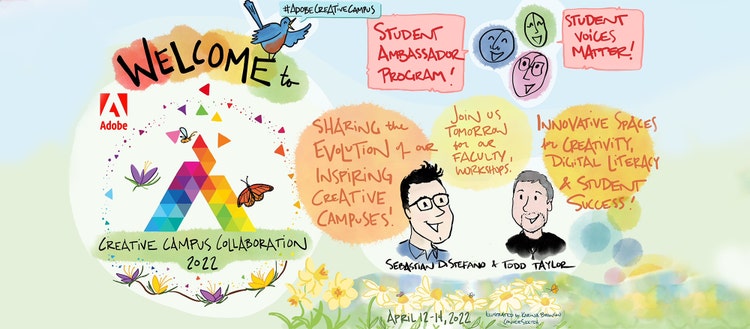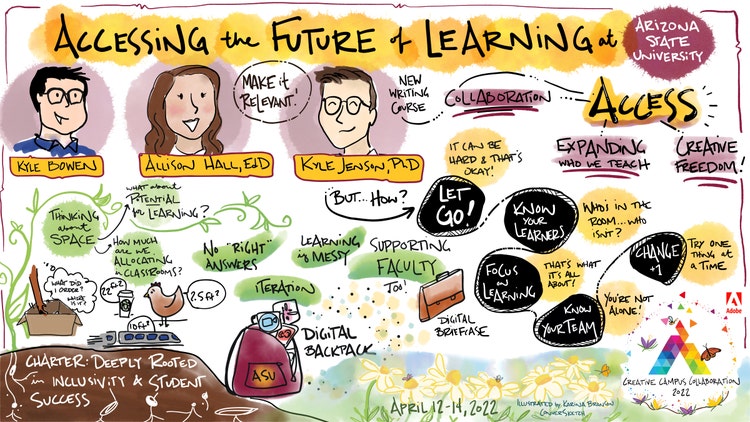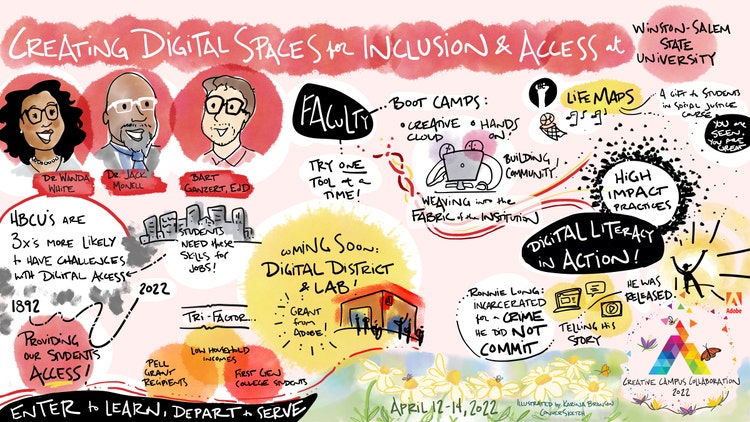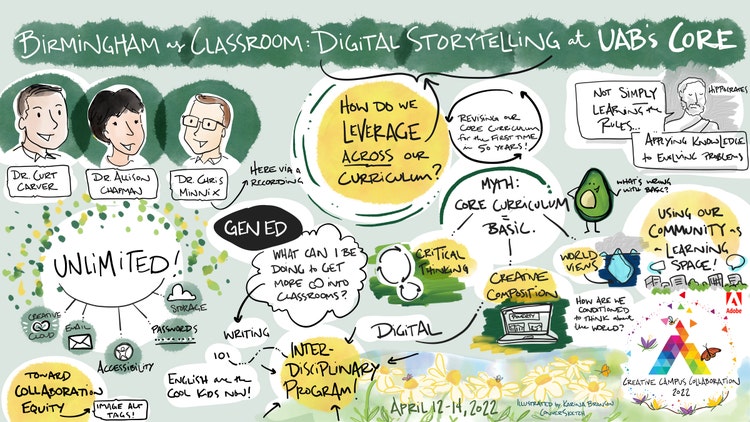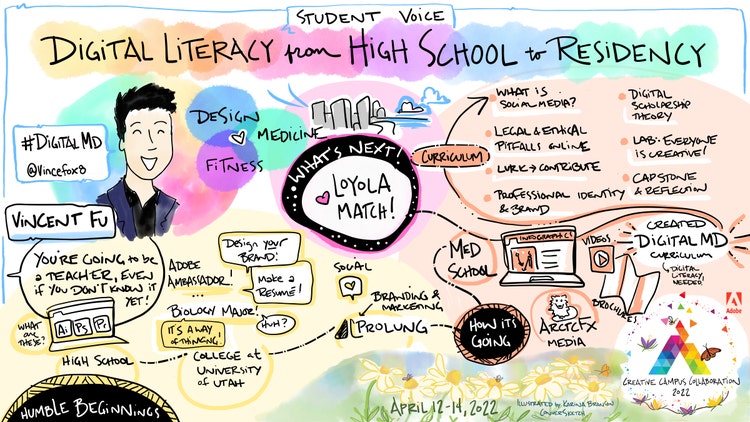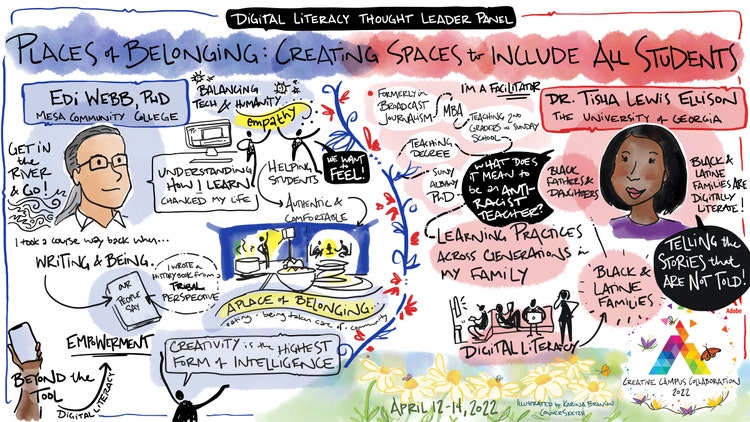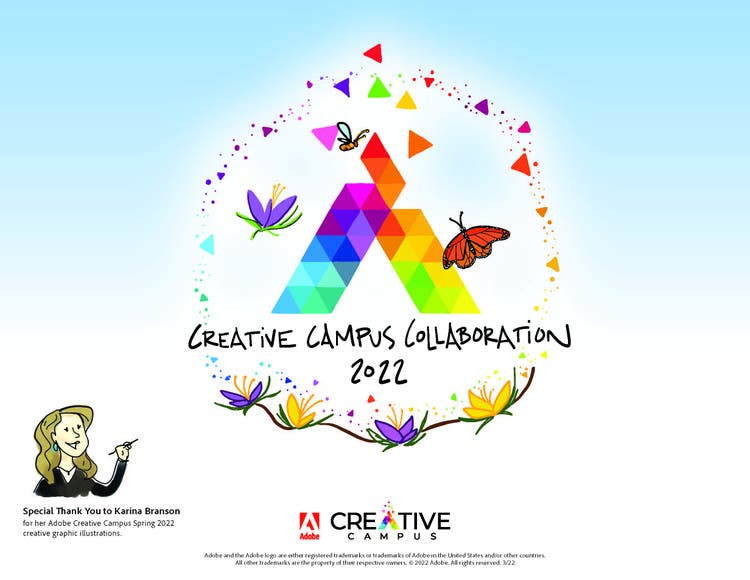In 2019, Adobe formally launched the Creative Campus program, which spotlights leading colleges around the world that recognize the value of teaching digital literacy and have made investments in digital tools to nurture creative skills and improve student outcomes. Since its inception, the program has expanded dramatically, recently welcoming its 59th participating institution, Fresno State University.
Last month, more than 200 faculty members and academic leaders joined host Todd Taylor, Adobe pedagogical evangelist and professor of English at the University of North Carolina Chapel Hill, at the latest Adobe Creative Campus Collaboration to discuss how colleges are enhancing teaching and learning strategies through “innovative spaces” and digital tools.
As universities navigate uncertainties ahead, one thing is clear: the future of learning must continue to evolve — whether it’s in virtual, physical or hybrid classrooms. If you weren’t able to attend the event, below are session highlights and new ideas that may help you reimagine learning spaces — designed to improve student retention and academic results.
Become an Adobe Creative Campus
Join a global community of innovative institutions equipping all students with Adobe tools to learn the creative and productivity skills employers seek.
Learn more
As a long-time Creative Campus collaborator and innovator, Arizona State University (ASU), has prioritized transforming traditional learning environments to promote student creativity, collaboration and success. Kyle Bowen, executive director of Learning Experience at ASU, kicked off the event with a discussion of how the 14th century model of packed lecture halls has yet to catch up to student needs and give them opportunities to be more active. This is necessary to develop essential collaborative and creative-thinking abilities in students.
“At the ASU enterprise, we have these realms of teaching — we have our traditional classrooms and our lecture halls, but we also have our digital immersion and infinitely scalable learning,” said Allison Hall, EdD, director, Learning Experience Design and Faculty Associate at the Herberger Institute for Design and the Art at ASU. “And all enrolled students are coming from different places and have different needs. And to take them all into consideration is a really important part of making sure there's a space for them — that we're not just focusing on one type of learner.”
Serving more than 120,000 students across its campuses, the university sought to adapt the way students learn with the creation of the “ASU Digital Backpack,” a set of tools used in the modern workforce that students can use to hone their digital literacy skills and complete course assignments. In addition, ASU provided faculty with a digital briefcase, which consists of tools that can empower them to learn something new themselves and engage students of all backgrounds.
Looking ahead to the future, Hall highlighted how ASU will continue to foster collaboration across the institution with learning resources such as “experience kits,” ready-to-teach lesson plans that prioritize the use of digital tools and technology rather than traditional lecture, as well as hosting annual Adobe Days, that give students hands-on training with Adobe experts.
Addressing disparities through digital learning spaces at Winston-Salem State University
Bridging the digital divide among students was a common mission for many colleges in the era of COVID-19, but for Winston-Salem State University (WSSU), the first HBCU to become an Adobe Creative Campus, the integral role of technology goes hand-in-hand with its long-standing vision to provide access to quality education for all students.
According to a recent study, one in three Black, Latino, and American Indian/Alaska Native households lack internet access, making students in those homes “more likely than their White peers to be disconnected from online learning.” Dr. Wanda White, director of Center for Innovative and Transformative Instruction (CITI) at WSSU, underscored how many students fall into what she calls the “trifecta” category of the digital divide, meaning they are either first generation college students, come from households with incomes of $50,000 or less, and/or are Pell Grant recipients.
“When students lack digital access, they are missing a piece of the puzzle, and we want to provide that last piece to the puzzle for our students,” Dr. White said. “This digital learning space will enhance our students’ employability, decrease the digital gap, provide access and inclusion to technological literacy, and let our students create and learn together.”
Globalizing general education at the University of Alabama at Birmingham
A common misconception in higher education that Dr. Chris Minnix, associate professor, director of the Signature Core Curriculum at the University of Alabama at Birmingham (UAB), set out to debunk is the notion that general education courses are basic. He described how many academics separate courses into two groups: those that teach students foundational skills including essential reading, writing, math and science skills, and more advanced, globally developed courses that enable students to build digital literacy. This school of thought tends to cause siloes in learning and often hinders students from seeing common threads between courses.
“One of the exciting things about teaching digital literacy and digital composing is that we find things like critical thinking, communication, visualizing quantitative data, even exploring issues of public science — those skills are not disconnected from civic engagement or global perspectives,” Dr. Minnix said. “In fact, students learn them from being immersed with them at the same time.”
Minnix points to UAB’s “City as a Classroom” course as an example of curriculum that immerses students across disciplines and enables them to hone their digital literacy skills. Students complete project-based assignments and research about the city of Birmingham to demonstrate their understanding of global issues and the impacts on their local community. Employing digital tools throughout the course gives students the opportunity to apply critical thinking, engage in self-reflection and explore ways to tell more compelling stories, which Dr. Minnix explained is a key learning outcome of general education that also prepares them for their future careers.
From grade school to residency: Vincent Fu’s The Digital Literacy Journey
Vincent Fu, a University of Utah alumnus currently in his final semester at the University of Colorado School of Medicine, reflected on his academic and professional journey over nearly two decades with graduation on the horizon. He explained how his passion for creativity evolved, for example when contextualizing complex topics in visually compelling and comprehensive ways for STEM assignments.
More recently, Fu leveraged Adobe Creative Cloud and other digital tools as part of his post-graduate studies to develop “Digital MD,” a course that aims to prepare current medical students — the doctors of tomorrow — for the challenges of telehealth, social media engagement and public advocacy by teaching them how to communicate. In developing the curriculum, Fu surveyed his students on their existing attitudes about social and digital media, which revealed that more than half recognized the importance of creating medical content for social media, yet did not know how to go about the process.
“There is a demand for digital literacy in medicine that was not being fulfilled at the time of surveying our students and so, with this in mind, we designed our modules to meet this identified gap in medical education,” Fu said.
Fu’s course enables students to gain the knowledge and technical skills needed to succeed in their pre-clinical years, and as a result, will continue to be offered by the University of Colorado even though he will be graduating. He begins his emergency medicine residency at Loyola University Medical Center in Chicago soon, where he plans to apply his digital expertise and creativity into his role as a physician.
The Adobe Creative Campus Collaboration wrapped with a closing panel featuring faculty members from diverse backgrounds who discussed the importance of creating spaces for students on campus that promote inclusivity. A lack of representation of people of color in creative and historic narratives inspired Dr. Eddie Webb, English Professor and director of the New Media Lab at Mesa Community College, and Dr. Tisha Lewis Ellison, associate professor of the Department of Language and Literacy Education at the University of Georgia, to determine how to eliminate conscious and unconscious biases in the classroom.
This effort prompted them both to reimagine the way they teach to ensure that all students have opportunities to share their real-life stories through a variety of traditional and digital tools.
“I realized if I was going to be a successful college teacher, I had to be partners with my students, not the guy in the front of the room trying to know everything,” Dr. Webb said. “And when I crossed that stream, that's when things opened up for me and I started learning as much about language and technology and tools from my students, as I was teaching.”
The strides that both Dr. Webb and Dr. Ellison made enhanced the empathy that students had for one another and helped them build the confidence to share their stories and establish a culture of inclusion on campus.
We’re excited to share that the next Adobe Creative Campus Collaboration will take place online via Zoom from June 14-16, 2022. If you’re interested in participating or would like to learn how your institution can join the coalition of more than 60 participating universities within the Adobe Creative Campus program, please contact your sales representative. For more information on how to integrate digital skills across disciplines and throughout curricula, please visit the Digital Literacy resources page.
